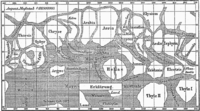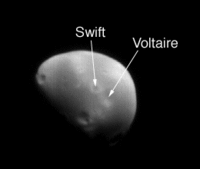Benutzer:LeastCommonAncestor/Planetologische Nomenklatur
- Liste der Features
http://planetarynames.wr.usgs.gov/SearchResults?featureType=Cavus,%20cavi
- Features auf Himmelskörper
http://planetarynames.wr.usgs.gov/SearchResults?target=MARS&featureType=Cavus,%20cavi
- Hinweis
Nach den Namenskonventionen der IAU werden für Oberflächenstrukturen auf Janus Namen mit Verbindung zum mythischen Zwillingspaar Castor und Pollux verwendet.[1]
Categories for naming features on planets and satellites[Bearbeiten | Quelltext bearbeiten]
The Moon[Bearbeiten | Quelltext bearbeiten]
| Feature type | Naming convention |
|---|---|
| Craters | Craters are generally named after deceased scientists, scholars, artists and explorers who have made outstanding or fundamental contributions to their field. Additionally, craters in or around Mare Moscoviense are named after deceased Russian cosmonauts and craters in and around Apollo crater are named after deceased American astronauts (see Space accidents and incidents). This convention may be extended if other space-faring countries suffer fatalities in spaceflight. |
| Lacūs, Maria, Paludes, Sinūs | These features are assigned names which are Latin terms describing weather and other abstract concepts. |
| Montes | Montes are named after terrestrial mountain ranges or nearby craters. |
| Rupēs | Rupēs are named after nearby mountain ranges (see above). |
| Valles | Valles are named after nearby features. |
| Others | Features that don't fall into any of the above categories are named after nearby craters. |
Mars and martian satellites[Bearbeiten | Quelltext bearbeiten]
Mars[Bearbeiten | Quelltext bearbeiten]

| Feature type | Naming convention |
|---|---|
| Large craters | Deceased scientists who have contributed to the study of Mars; writers and others who have contributed to the lore of Mars |
| Small craters | Villages of the world with a population of less than 100,000. |
| Large valles | Name for Mars/star in various languages |
| Small valles | Classical or modern names of rivers |
| Other features | From nearest named albedo feature on Schiaparelli or Antoniadi maps. See Classical albedo features on Mars for a list. |
When space probes have landed on Mars, individual small features such as rocks, dunes, and hollows have often been given informal names. Many of these are frivolous: features have been named after ice cream (such as Cookies N Cream); cartoon characters (such as SpongeBob SquarePants and Patrick); and '70s music acts (such as ABBA and the Bee Gees).[2]
Deimos[Bearbeiten | Quelltext bearbeiten]

Features on Deimos are named after authors who wrote about Martian satellites. There are currently two named features on Deimos - Swift crater and Voltaire crater - after Jonathan Swift and Voltaire who predicted the presence of Martian moons.
Phobos[Bearbeiten | Quelltext bearbeiten]
Vorlage:Seealso All features on Phobos are named after scientists involved with the discovery, dynamics, or properties of the Martian satellites or people and places from Jonathan Swift's Gulliver's Travels.
Satellites of Jupiter[Bearbeiten | Quelltext bearbeiten]
Amalthea[Bearbeiten | Quelltext bearbeiten]
Vorlage:See also People and places associated with the Amalthea myth
Thebe[Bearbeiten | Quelltext bearbeiten]
Features on Thebe are named after people and places associated with the Thebe myth. There is only one named feature on Thebes - Zethus crater.
Io[Bearbeiten | Quelltext bearbeiten]
| Feature type | Naming convention |
|---|---|
| Active eruptive centers | Active volcanoes on Io are named after fire, sun or thunder gods or heroes. |
| Catenae | Crater chains are named after Sun gods. |
| Fluctūs | Names of fluctūs are derived from a nearby named feature, fire, sun, thunder or volcano gods, goddesses and heroes or mythical blacksmiths. |
| Mensae, Montes, Plana, Regiones and Tholi | These features can be named after places associated with Io mythology, derived from nearby named features, or places from Dante's Inferno |
| Paterae | Paterae on Io are named after fire, sun, thunder or volcano gods, heroes or goddesses or mythical blacksmiths. |
| Valles | Names of valleys are derived from nearby named features. |
Europa[Bearbeiten | Quelltext bearbeiten]
| Feature type | Naming convention |
|---|---|
| Chaos | Places associated with Celtic myths |
| Craters | Celtic gods and heroes |
| Flexūs | Places associated with the Europa myth |
| Large ringed features | Celtic stone circles |
| Lenticulae | Celtic gods and heroes |
| Lineae | People associated with the Europa myth |
| Maculae | Places associated with the Europa myth |
| Regiones | Places associated with Celtic myths |
Ganymede[Bearbeiten | Quelltext bearbeiten]
| Feature type | Naming convention |
|---|---|
| Catenae, craters | Gods and heroes of ancient Fertile Crescent people |
| Faculae | Places associated with Egyptian myths |
| Fossae | Gods (or principals) of ancient Fertile Crescent people |
| Paterae | Paterae on Ganymede are named after wadis in the Fertile Crescent. |
| Regiones | Astronomers who discovered Jovian satellites |
| Sulci | Places associated with myths of ancient people |
Callisto[Bearbeiten | Quelltext bearbeiten]
| Feature type | Naming convention |
|---|---|
| Large ringed features | Homes of the gods and of heroes |
| Craters | Heroes and heroines from northern myths |
| Catenae | Mythological places in high latitudes |
Satellites of Saturn[Bearbeiten | Quelltext bearbeiten]
Nach den Namenskonventionen der IAU werden für Oberflächenstrukturen auf Janus Namen mit Verbindung zum mythischen Zwillingspaar Castor und Pollux verwendet.[3]
Enceladus[Bearbeiten | Quelltext bearbeiten]
People and places from Burton's Arabian Nights
Tethys[Bearbeiten | Quelltext bearbeiten]
People and places from Homer's Odyssey
Dione[Bearbeiten | Quelltext bearbeiten]
People and places from Virgil's Aeneid
Rhea[Bearbeiten | Quelltext bearbeiten]
People and places from creation myths
Titan[Bearbeiten | Quelltext bearbeiten]
| Feature type | Naming convention |
|---|---|
| Major bright albedo features | Sacred or enchanted places from legends, myths, stories, and poems of cultures from around the world |
| Major dark albedo features | Legendary/mythical primordial seas or enchanted waters from world cultures |
| Craters (and lakes if present) | Lakes from all continents on Earth |
| Fluvial channels | Rivers from all continents on Earth |
| Other features | Deities of happiness, peace, and harmony from world cultures |
Hyperion[Bearbeiten | Quelltext bearbeiten]
Vorlage:See also Sun and Moon deities
Iapetus[Bearbeiten | Quelltext bearbeiten]
Vorlage:See also People and places from Sayers' translation of Chanson de Roland
Phoebe[Bearbeiten | Quelltext bearbeiten]

| Feature type | Naming convention |
|---|---|
| Craters | Craters of Phoebe are named after people associated with Phoebe or people from Argonautica by Apollonius Rhodius or Gaius Valerius Flaccus. |
| Other | Non-crater features on Phoebe are named after places from Argonautica. |
Satellites of Uranus[Bearbeiten | Quelltext bearbeiten]
Puck[Bearbeiten | Quelltext bearbeiten]
Vorlage:See also Mischievous (Pucklike) spirits (class)
Miranda[Bearbeiten | Quelltext bearbeiten]
Vorlage:See also Characters, places from Shakespeare's plays
Ariel[Bearbeiten | Quelltext bearbeiten]
Vorlage:See also Light spirits (individual and class)
Titania[Bearbeiten | Quelltext bearbeiten]
Vorlage:See also Female Shakespearean characters, places
Oberon[Bearbeiten | Quelltext bearbeiten]
Vorlage:See also Shakespearean tragic heroes and places
Small satellites[Bearbeiten | Quelltext bearbeiten]
There are currently no named features on Uranian small satellites, however the naming convention is heroines from plays by Shakespeare and Pope.
Satellites of Neptune[Bearbeiten | Quelltext bearbeiten]
Proteus[Bearbeiten | Quelltext bearbeiten]
Vorlage:See also Features on Proteus are to be named after water-related spirits, gods or goddesses who are neither Greek nor Roman. The only named feature on Proteus is Pharos.
Triton[Bearbeiten | Quelltext bearbeiten]
Vorlage:See also Geological features on Triton should be assigned aquatic names, excluding those which are Roman and Greek in origin. Possible themes for individual descriptor terms include worldwide aquatic spirits, famous terrestrial fountains or fountain locations, terrestrial aquatic features, famous terrestrial geysers or geyser locations and terrestrial islands.
Nereid[Bearbeiten | Quelltext bearbeiten]
There are currently no named features on Nereid. When features are discovered, they are to be named after individual nereids.
Small satellites[Bearbeiten | Quelltext bearbeiten]
Features on other satellites of Neptune, once discovered, should be named after gods and goddesses associated with Neptune/Poseidon mythology or generic mythological aquatic beings.
Pluto[Bearbeiten | Quelltext bearbeiten]
There are currently no named features on Pluto because it is extremely difficult to resolve surface features with current telescopes.[4][5] When discovered, either by telescopic observation or the New Horizons flyby in 2015, Plutonian surface features are to be named after underworld deities.
Asteroids[Bearbeiten | Quelltext bearbeiten]
243 Ida[Bearbeiten | Quelltext bearbeiten]
| Feature type | Naming convention |
|---|---|
| Craters | Caverns and grottos of the world |
| Dorsa | Galileo project participants |
| Regiones | Discoverer of Ida and places associated with the discoverer |
(243) Ida I Dactyl[Bearbeiten | Quelltext bearbeiten]
| Feature type | Naming convention |
|---|---|
| Craters | Idaean dactyls |
951 Gaspra[Bearbeiten | Quelltext bearbeiten]
| Feature type | Naming convention |
|---|---|
| Craters | Spas of the world |
| Regiones | Discoverer of Gaspra, and Galileo project participants |
253 Mathilde[Bearbeiten | Quelltext bearbeiten]
| Feature type | Naming convention |
|---|---|
| Craters | Coal fields and basins of the world |
433 Eros[Bearbeiten | Quelltext bearbeiten]
| Feature type | Naming convention |
|---|---|
| Craters | Mythological and legendary names of an erotic nature |
| Regiones | Discoverers of Eros |
| Dorsa | Scientists who have contributed to the exploration and study of Eros |
25143 Itokawa[Bearbeiten | Quelltext bearbeiten]
The IAU has named craters and regiones on Itokawa but has not disclosed any naming conventions. [6][7]
Einzelnachweise[Bearbeiten | Quelltext bearbeiten]
- ↑ Categories for Naming Features on Planets and Satellites - IAU Working Group for Planetary System Nomenclature (WGPSN)
- ↑ Jia-Rui Chong: Map of Mars fills up with strange names In: Pittsburgh Post-Gazette, 9. Oktober 2005. Abgerufen am 18. April 2008
- ↑ Categories for Naming Features on Planets and Satellites - IAU Working Group for Planetary System Nomenclature (WGPSN)
- ↑ Planetary Nomenclature FAQ. Abgerufen am 18. April 2008.
- ↑ Hubble Reveals Surface of Pluto for First Time. In: Hubblesite. 1996, abgerufen am 18. April 2008.
- ↑ http://planetarynames.wr.usgs.gov/append6.html
- ↑ http://astrogeology.usgs.gov/HotTopics/index.php?/archives/356-Fourteen-New-Names-Approved-for-Craters-and-Regiones-on-Itokawa.html